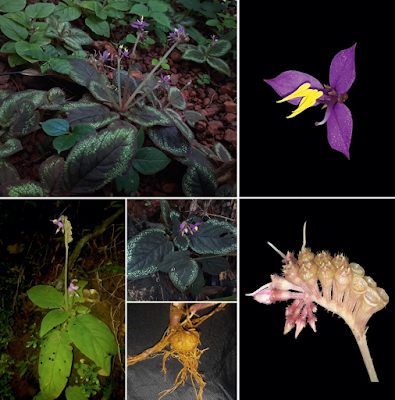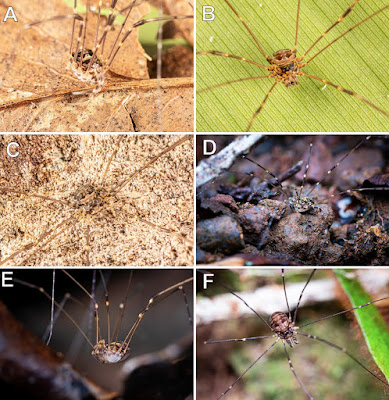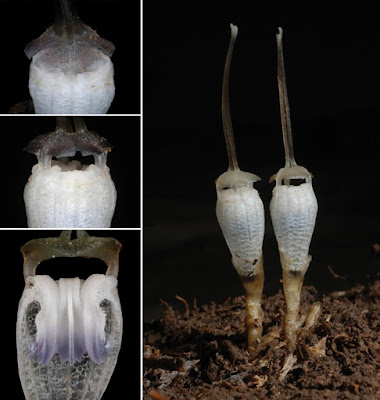[Most Recent Entries] [Calendar View]
Saturday, June 12th, 2021
| Time | Event | ||||
| 3:00a | [Botany • 2021] Sonerila kanjilasseriensis (Melastomataceae) • A New Tuberous Species from Kerala, India
Summary A new tuberous species of Sonerila from suburban areas of Kozhikode district of Kerala, India is described and illustrated as Sonerila kanjilasseriensis sp. nov. The new species resembles S. rheedei Wall. ex Wight & Arn., but differs in having a subterranean tuber, cylindrical to sub-quadrangular stem, many-flowered cyme, acuminate apex of the petals and distinctly 4 – 6-ribbed hypanthium and capsule. A detailed description, comparison, photographs and illustrations are provided. Key Words: Endemic, new species, taxonomy
Sonerila kanjilasseriensis Arunraj, R.Reshma & Vishnupr., sp. nov. RECOGNITION. Sonerila kanjilasseriensis is closely similar to S. rheedei Wall. ex Wight & Arn. (a species endemic to the southern Western Ghats) in its caulescent habit, non-glandular hairs on leaves and stem, large ovate-elliptic leaves with obtuse to acute tip, petiole up to 6 cm long, peduncle up to 12 cm long, glabrous petal margins, beaked anthers and campanulate capsules. But the former can be easily distinguished from the latter in having a subterranean tuber (vs absence of subterranean tuber), the cylindrical to subquadrangular stem (vs quadrangular stem), (10 –) 12 – 24 (– 29) flowers per cyme (vs 6 – 12 flowers per cyme, very rarely up to 14), petals with an acuminate apex (vs mostly acute or rarely mucronate apex), and the distinctly 4 – 6-ribbed hypanthium and capsule (vs indistinctly ribbed hypanthium and capsule). ETYMOLOGY. The specific epithet corresponds to the type locality P. T. Arunraj, Reshma Raju and C. P. Vishnuprasad. 2021. Sonerila kanjilasseriensis (Melastomataceae), A New Tuberous Species from Kerala, India. Kew Bulletin. 76; 77–84. DOI: 10.1007/s12225-021-09929-4 | ||||
| 3:11a | [Arachnida • 2021] Martensopsalis dogny • A New Genus of Neopilionidae (Opiliones: Eupnoi) from New Caledonia Abstract New Caledonia has an endemic opiliofauna with two named species of Triaenonychidae, 17 Troglosironidae and eight Zalmoxidae. The recent finding of Neopilionidae on Grande Terre was thus surprising, and required the formal description of a new genus, which we undertake here. Martensopsalis gen. nov. is characterized by a small unsclerotized body with a unique palp with a pointed basal apophysis on the ventral side of the femur and with a distal apophysis on the prolateral side of the patella. The distinct external morphology, simple penis and unique phylogenetic position justify the erection of the new genus with Martensopsalis dogny spec. nov. as its type species. In addition to the type locality we report several other localities of putative congeneric, yet undescribed species. Keywords: Opiliones, Gondwana, harvestmen, taxonomy, Zealandia Neopilionidae Lawrence, 1931 Martensopsalis Giribet & Baker gen. nov. Diagnosis. Martensopsalis can be distinguished from all other genera of Neopilionidae by the presence of a pointed basal apophysis on the ventral side of the palpal femur (Figs 3, 4C), although being more conspicuous in some individuals than others; palpal patella with a distal-prolateral apophysis (Figs 3, 4C), also with different degrees of development; palpal patella and tibia of similar size; palpal tarsus longer than other articles; a dense set of thick setae on all palpal articles; palpal claw well developed and smooth. Penis with long sclerotized straight shaft with a short glans, and the stylus being a coiled tube; without bristles, spines or setae. Etymology. Named for our dear colleague Jochen Martens for his contributions and enormous influence on Opiliones systematics. The second part of the generic name is the classical Greek noun “psalis” (= scissors) which has been previously used in the names of other genera of Neopilionidae such as Megalopsalis, Forsteropsalis and Pantopsalis. The gender is feminine. Distribution. Widespread in the southern half of New Caledonia’s Grande Terre. Martensopsalis dogny Giribet & Baker spec. nov. Etymology. The specific epithet, a noun in apposition, refers to the type locality, an emblematic mountain of New Caledonia that served as a place for exchange between the tribes from the east and the west of Grande Terre. Distribution. Only known from its type locality, the Plateau de Dogny, at an elevation above 900 m. Gonzalo Giribet, Caitlin M. Baker and Damien Brouste. 2021. Martensopsalis, A New Genus of Neopilionidae from New Caledonia (Opiliones: Eupnoi). Zootaxa. 4984(1); 98–107. DOI: 10.11646/zootaxa.4984.1.9 | ||||
| 3:12a | [Botany • 2021] Thismia clavigeroides (Thismiaceae) พิศวงเขาหลัก • A New Mycoheterotrophic Species from Thailand
Abstract Thismia clavigeroides is described and illustrated as a new species from southern Thailand. The new species is characterized by coralliform roots, whitish-gray flowers, reflexed outer perianth lobes, inner perianth lobes forming a mitre with three slender claviform appendages, inner surface of floral tube possessing transverse bars, and the apex of stamen bearing three triangular lobes. A taxonomic description, illustrations of the new species, and a comparison with the related species are presented. Thismia clavigeroides Chantanaorr. & Seelanan, sp. nov. Etymology— The new species is named after the great morphological similarity to T. clavigera. Sahut Chantanaorrapint and Tosak Seelanan. 2021. Thismia clavigeroides (Thismiaceae), A New Mycoheterotrophic Species from Thailand. Systematic Botany. 46(1); 18-23. DOI: 10.1600/036364421X16128061189468 พิศวง อุทยานแห่งชาติเขาหลัก-ลำรู่ |
| << Previous Day |
2021/06/12 [Calendar] |
Next Day >> |
















